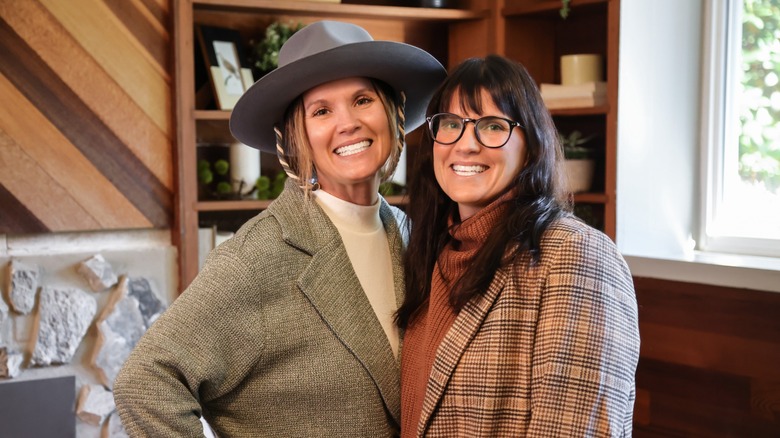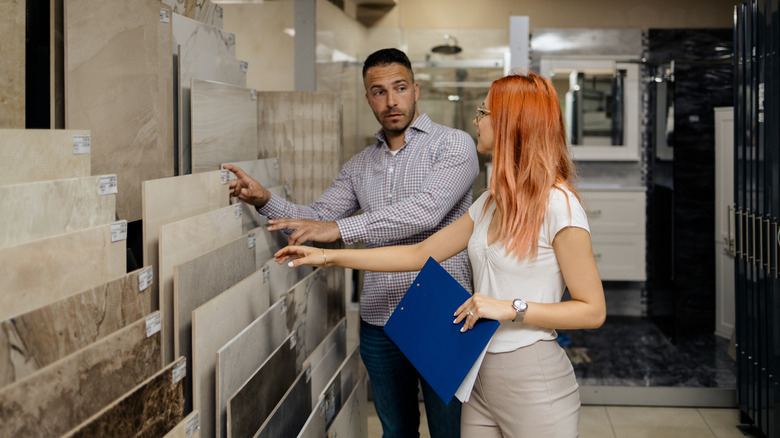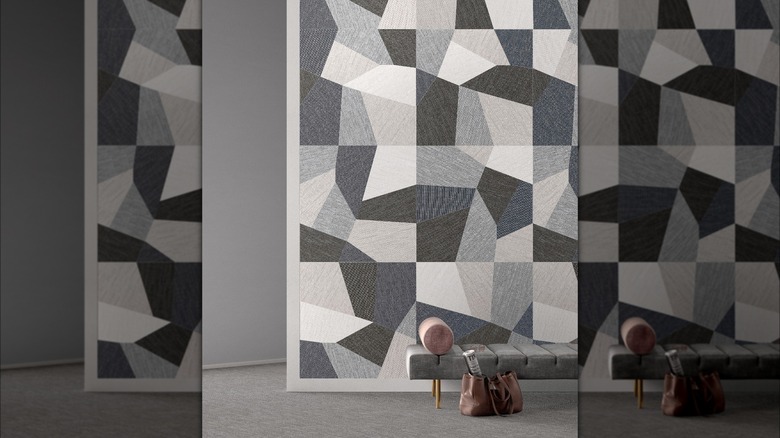The Stunning Floor Type The Stars Of Unsellable Houses Can't Stop Using In Homes
Flooring is not a feature that should be overlooked. It should be as durable as it is beautiful, and that comes by choosing the right material. Lyndsay Lamb and Leslie Davis from HGTV's "Unsellable Houses" have used a variety of materials in the homes they've redesigned, but porcelain tile seems to be a favorite for the designing duo. Lamb and Davis have used porcelain tile in the bathroom, entryway, and kitchen of various homes they've remodeled. The results are stunning and modern rooms with stylish flooring as the base.
However, the idea of porcelain floors might give some homeowners pause. Porcelain has the connotation of being delicate and easily breakable, but porcelain flooring isn't exactly the same as porcelain dolls. The tiles are formed under high pressure and at temperatures over 2,000 degrees Fahrenheit. This fabrication process makes porcelain tiles a durable flooring option, even in high-traffic areas of the home, and a good flooring option for homes with children. The clays, feldspar, and sand used to produce porcelain tiles also contribute to their durability, not to mention greater resistance to scratches than other tiles. It's no wonder Lamb and Davis opt to use this material in many of their redesigns.
Why porcelain is ideal
Beyond the durability of porcelain tiles, there are plenty of reasons why Lyndsay Lamb and Leslie Davis choose this material over others when it comes to flooring. Porcelain tiles often have texture or can be made to look like other materials, including wood, marble, and other stones. Lamb and Davis have even used porcelain tile with a linen-like finish to add subtle texture to the floor.
Because of the material and fabrication process, porcelain tiles are water-resistant. This prevents moisture from seeping into the material, causing cracks and discoloration. While porcelain tiles aren't completely non-porous, they have a minimal porosity, often less than 0.5%, which is less than most other natural stones. This low level of porosity is what makes porcelain tile a great flooring option for kitchens and bathrooms, where water splashes and spills are common, and even an entryway, where shoes may track in rainwater and snow.
Another benefit of porcelain is the low-maintenance aspect of the material. Though it can be sealed, porcelain tile doesn't require sealing like natural stone, so you won't have to worry about continued maintenance to keep the tile looking its best.
Designing with porcelain tile
Comparatively, porcelain is an inexpensive flooring material, averaging between $3 and $10 a square foot. This is a little more than similar ceramic tile but less expensive than natural stones such as marble, for which porcelain is a great alternative. Being relatively inexpensive makes porcelain a great choice if you're looking to update your floors on a budget.
While many people think of porcelain as a white material, that isn't necessarily true for porcelain tile. For the aforementioned entryway, Lyndsay Lamb and Leslie Davis used an option from Arizona Tile that features a mix of shapes in gray, blue, black, and white. Tile is a great way to add color, pattern, and texture to a room, though strong patterns can easily overwhelm a space, so keeping other features minimal will help the tile to stand out and keep the room from looking too busy. With the Arizona tile, Lamb and Davis opted to keep the walls white, adding wood accents to create some contrast. Keeping the patterned tile in only the entryway also helped to define the space.
Of course, colorful and patterned porcelain tile isn't the only option. Lamb and Davis have used more understated, neutral-colored tiles in their designs. This creates a simple base that allows for a statement in other places, such as a patterned shower wall or backsplash in the kitchen. Porcelain tile's versatility and durability make it a great flooring choice.


